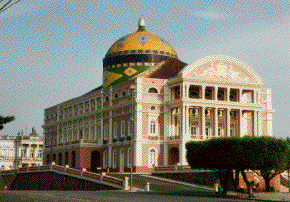
|

|

This 1.5 million city lies along the north bank of the Negro River, 11 miles (18 km) above its confluence with the Amazon (Solimões). It is located 900 miles (1,450 km) inland from the Atlantic coast in the heart of the Amazon rain forest. As a major inland port (reached by oceangoing vessels from the Atlantic) it is a collecting and distribution center for the river areas of the upper Amazon. Principal exports include rubber, Brazil nuts, rosewood oil, jute, and a host of minor forest products; cordage and coffee sacks are made from jute. Manaus' industries include brewing, shipbuilding, soap manufacturing, the production of chemicals, the manufacture of electronics equipment, and petroleum refining (the oil being brought by barge down the Amazon from Peru).
The first European settlement on the site was a small fort (São Jose do Rio Negrinho) built in 1669. A small settlement developed and in 1850 became the capital of the province of Amazonas. From 1890 to 1920 the rubber boom brought prosperity to the city, actually to a few rubber barons who brutally used Indians to collect the latex from the rubber trees. During this period the great Opera House was constructed. The best entertainers from Europe and North America were brought in for the pleasure of the 100 or so families that then controlled the economy of the area. With the advent of synthetic rubber in the early 1920's (as well as development of rubber plantations in SE Asia -- an Englishman Sir Henry Wickham "clandestinely" collected rubber seeds from the wild trees of the Amazon jungles) the economic importance of natural rubber, and consequently that of Manaus declined considerably. In the late 1970s the Brazilian government and private companies began extensive development the mineral and agricultural wealth of the surrounding rain-forested region. To encourage even further commercial and tourist development Manaus has also been declared a "Zona-Franca" (duty free zone). Billions of dollars worth of goods enter Manaus yearly for distribution to other parts of Brazil.
Images:
Top of Page * Choose Another Destination
Top of Page *
Choose Another
Destination
Acre
, Amapa
, Amazonas
, Para
, Rondonia
, Roraima
, Tocantins
Top of Page *
Choose Another
Destination
General Information
Top of Page *
Choose Another
Destination
General Information
Top of Page *
Choose Another
Destination

The State of Amazonas
Population : 2,150,000
Capital : Manaus
![]()
The States

Rondônia

![]()

Acre
![]()

Roraima
![]()

The State of Pará

Top of Page * Choose Another Destination
|
General Information
Top of Page * Choose Another Destination
Amapá
|

|
Top of Page * Choose Another Destination
Please feel free to send me your comments via e-mail. Contribuições Welcomed!!!